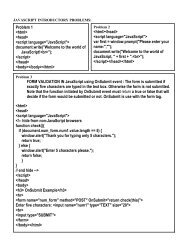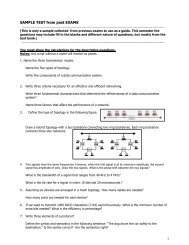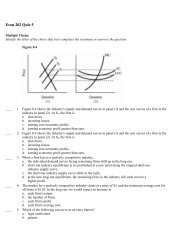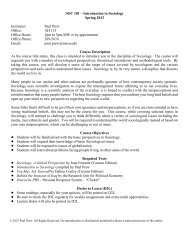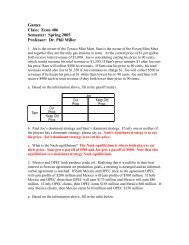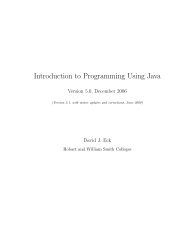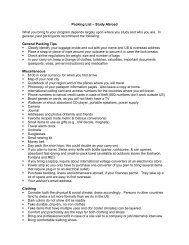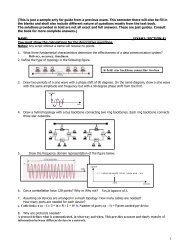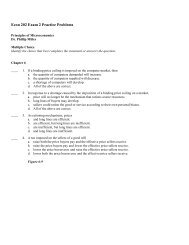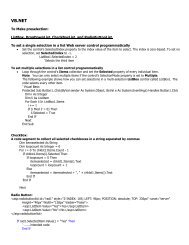Figure 2. Equivalent circuit of figure 1 if RE= R1+R2+R3 ... - Krypton
Figure 2. Equivalent circuit of figure 1 if RE= R1+R2+R3 ... - Krypton
Figure 2. Equivalent circuit of figure 1 if RE= R1+R2+R3 ... - Krypton
Create successful ePaper yourself
Turn your PDF publications into a flip-book with our unique Google optimized e-Paper software.
EET-112: Elementary Electronics<br />
The values <strong>of</strong> I1, I2 and I3 will be depend on the values <strong>of</strong> R1, R2 and R3 respectively and will be discussed in<br />
the subsequent units. If R1=R2=R3, then the following relationship will be true: I1=I2=I3.<br />
The following relationship will always also be true. It means that the current flowing into a node will be equal to<br />
the sum <strong>of</strong> the current flowing out <strong>of</strong> the node.<br />
I = I1 + I2 + I3<br />
Example: If the values <strong>of</strong> the three resistors are:<br />
R1= 10Ω, R2=10Ω, and R3=20Ω Then the equivalent RE resistance can be calculated as<br />
1/RE = 1/10 + 1/10 + 1/20 = .1 + .1 + .05 = .25<br />
So, 1/RE = .25 i.e RE = 1/.25 = 4Ω<br />
Using the formula <strong>of</strong> Ohm’s Law, as used in series <strong>circuit</strong>, V=I/R we can calculate the current.<br />
In the above example, <strong>if</strong> the battery has a voltage value <strong>of</strong> 10 V, then the total current in the <strong>circuit</strong> is: I = V/R<br />
= 10/4 = <strong>2.</strong>5 A.<br />
As we discussed that for parallel <strong>circuit</strong> the voltage across each resistor is same i.e. 10 V, so:<br />
I 1 = V/R1 = 10/10 = 1 A<br />
I 2 = V/R2 = 10/10 = 1 A<br />
I 3 = V/R3 = 10/20 = 0.5 A<br />
Note that I1+I2+I3 = 1 + 1 + .5 = <strong>2.</strong>5 equals to the total current I=<strong>2.</strong>5A.<br />
Important points to Remember on Series and parallel Circuits:<br />
For Serial Circuits:<br />
- Series <strong>circuit</strong>s have only one path, so the amount <strong>of</strong> flow <strong>of</strong> current is same through all resistors. If any<br />
part <strong>of</strong> the series <strong>circuit</strong> is broken no current will flow through the <strong>circuit</strong>.<br />
- The amount <strong>of</strong> current in <strong>circuit</strong> is: I=V/RE. (V in volts, RE in Ohms and I in amperes)<br />
- Voltage on each resistor will be d<strong>if</strong>ferent depending on the value <strong>of</strong> the resistor.<br />
V1=IR1, V2=IR2, V3=IR3<br />
- The sum <strong>of</strong> the voltage on individual resistor is equal to the output voltage <strong>of</strong> the source.<br />
V = V1+ V2+ V3<br />
- The equivalent resistor in series can be calculated with the formulae: RE = <strong>R1+R2+R3</strong><br />
For Parallel Circuits:<br />
- Voltage is the same for along parallel paths, but current splits to d<strong>if</strong>ferent branches.<br />
- Parallel <strong>circuit</strong>s have two or more paths for flow <strong>of</strong> current. Amount <strong>of</strong> current through a path depends on<br />
the value <strong>of</strong> the resistors. Formulas; I1 = V/R1, I2 = V/R2 and I3 = V/R3<br />
- The sum <strong>of</strong> the current through individual path is equal to the total current that flows from the source.<br />
I = I1+ I2 + I3<br />
- The equivalent resistor in parallel can be calculated with the formulae: 1/<strong>RE=</strong>1/R1+1/R2+1/R3<br />
- If one <strong>of</strong> the parallel path is broken, current will continue to flow through the remaining path.<br />
- If one <strong>of</strong> the parallel path is short <strong>circuit</strong>ed (i.e. connected with a wire meaning resistance =0) then all<br />
current will flow through the short <strong>circuit</strong> and RE will become zero ohm.<br />
Visit the URL: ‘http://home.att.net/~basicelectronics/parallel.htm’ for more explanation with <strong>figure</strong>s and in an<br />
easy to understand approach.<br />
Also visit: http://www.antonine-education.co.uk/Physics_AS/Module_3/Topic_3/topic_3__series_and_parallel_cir.htm<br />
Circuits with combination <strong>of</strong> series and parallel components<br />
Many <strong>circuit</strong>s have a combination <strong>of</strong> series and parallel resistors. Generally, the total resistance in such a <strong>circuit</strong> is<br />
found by reducing the d<strong>if</strong>ferent series and parallel combinations step-by-step to end up with a single equivalent<br />
Unit 2sup/page 3 <strong>of</strong> 8



